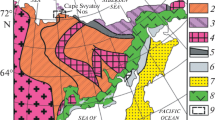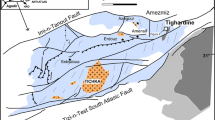Abstract
This publication presents new data on the chemical composition of rocks from the volcanogenic part of the Shirokopadinskaya Formation in the Bereya River basin of the Amur fragment of the northeastern flank of the South Mongolia–Khingan orogenic belt, (SMKhOB) as well as the results of geochronological (U–Th–Pb, LA–ICP– MS) and isotope (Lu–Hf) studies on zircons from crystal tuff. Metabasaltic andesites, their tuffs, and tuffites dominate among the volcanic and volcano-sedimentary rocks of the Shirokopadinskaya Formation. The geochemical features of the rocks and Hf-isotope composition of zircons from volcanic rocks indicate their suprasubduction origin. The concordant age of the youngest zircon population from crystal tuff is 589 ± 5 Ma (MSWD = 0.60, concordance probability = 0.90%), which corresponds to the Ediacaran. These zircons are characterized by well-preserved crystal faceting without traces of roundness. In our opinion, the age of the tuffs reflects the age of volcanism and the studied volcanic rocks. The data are rather unexpected, because the oldest rocks of the oceanic crust of the South Mongolia–Khingan orogenic belt are Ordovician in age. This means that the studied volcanic rocks are more than 100 million years older and cannot be a part of the South Mongolia–Khingan belt. The Ediacaran volcanic rocks are restricted to the boundary between the South Mongolia–Khingan orogenic belt and the Mamyn (Xing’an) terrane. They are a fragment of the Mamyn (Xing’an) terrane, which was tectonically placed into the present-day structure of the South Mongolia-Khingan orogenic belt. This conclusion is supported by the presence of rocks of similar age and geochemical composition in the Mamyn (Xing’an) terrane.









Similar content being viewed by others
REFERENCES
Geodynamics, Magmatism, and Metallogeny of East Russia, Ed. by A. I. Khanchuk (Dal’nauka, Moscow, 2006) [in Russian].
L. M. Parfenov, N. A. Berzin, A. I. Khanchuk, G. Bodarch, V. G. Belichenko, A. N. Bulgatov, S. I. Dril’, G. L. Kirillova, M. I. Kuzmin, U. J. Nokleberg, A.V. Prokop’ev, V. F. Timofeev, O. Tomurtogoo, and H. Jahn, “Model of formation of orogenic belts of Central and Northeastern Asia,” Tikhookean. Geol. 22 (6), 7–41 (2003).
N. N. Petruk and Yu. R. Volkova, State Geological Map of the Russian Federation. 1 : 1 000 000. Sheet M-52 (Blagoveshchensk). Far East Series. Third Generation, Ed. by A. S. Vol’sky (VSEGEI. St. Petersburg, 2012) [in Russian].
A. N. Serezhnikov and Yu. R. Volkova, State Geological Map of the Russian Federation. 1 : 1 000 000. Sheet N-52 (Zeya). Far East Series. Third Generation, Ed. by A. S. Vol’sky (VSEGEI. St. Petersburg, 2007) [in Russian].
Yu. V. Smirnov, A. A. Sorokin, and N. M. Kudryashov, “Early Paleozoic gabbro-amphibolites in the structure of the Bureya Terrane (eastern part of the Central Asian Fold Belt): first geochronological data and tectonic position,” Dokl. Earth Sci. 445 (1), 796–801 (2012).
Yu. V. Smirnov, A. A. Sorokin, A. B. Kotov, E. B. Sal’nikova, S. Z. Yakovleva, and B. M. Gorokhovskii, “Early Paleozoic monzodiorite–granodiorite association in the northeastern flank of the South Mongolia–Khingan Orogenic Belt (Nora–Sukhotinsky Terrane): age and tectonic setting,” Russ. J. Pac. Geol. 10 (2), 123–131 (2016).
Yu. V. Smirnov, A. A. Sorokin, and N. M. Kudryashov, “The first evidence for Late Devonian granitoid magmatism in the northeastern flank of the South Mongolia–Khingan orogenic belt,” Russ. J. Pac. Geol. 15 (1), 39–50 (2021).
A. A. Sorokin, A. B. Kotov, N. M. Kudryashov, and V. P. Kovach, “First evidence of Ediacaran magmatism in the geological history of the Mamyn Terrane of the Central Asian Fold Belt,” Russ. J. Pac. Geol. 9 (6), 399–410 (2015).
A. A. Sorokin, Yu. V. Smirnov, and Yu. N. Smirnova, “Geochemical features and sources of clastic material in Paleozoic terrigenous deposits of the northeastern flank of the South Mongolia–Khingan orogenic belt,” Stratigraphy. Geol. Correlation 25 (2), 146–166 (2017).
A. P. Sorokin, State Geological Map of the USSR. 1 : 200 000. Sheet M-52-I (Bereya River Mouth). Amuro–Zeya Series, Ed. by V. V. Shikhanova (Aerogeologiya, Moscow, 1975) [in Russian].
V. V. Yarmolyuk, V. I. Kovalenko, E. B. Sal’nikova, I. K. Kozakov, A. B. Kotov, V. P. Kovach, N. V. Vladykin, and S. Z. Yakovleva, “U–Pb age of syn- and postmetamorphic granitoids of South Mongolia: evidence for the presence of Grenvillides in the Central Asian Foldbelt,” Dokl. Earth Sci. 404 (1), 986–990 (2005).
Y. Amelin and W. J. Davis, “Geochemical test for branching decay of 176Lu,” Geochim. Cosmochim. Acta 69 (2), 465–473 (2005).
A. Bouvier, J. D. Vervoort, and P. J. Patchett, “The Lu-Hf and Sm-Nd isotopic composition of CHUR: constraints from unequilibrated chondrites and implications for the bulk composition of terrestrial planets,” Earth Planet. Sci. Lett. 273, 48–57 (2008).
W. A. Deer, R. A. Howie, and J. Zussman, Rock-Forming Minerals (Longmans, London, 1963), Vol. 2.
G. Gehrels, “Detrital zircon U-Pb geochronology: current methods and new opportunities,” Tectonics of Sedimentary Basins: Recent Advances, Ed. by C. Busby and A. A. Perez (Wiley-Blackwell, 2011), pp. 47–62.
W. L. Griffin, E. A. Belousova, S. R. Shee, N. J. Pearson, and S. Y. O’Reilly, “Archean crustal evolution in the Northern Yilgarn Craton: U-Pb and Hf-isotope evidence from detrital zircons,” Precambrian Res. 131, 231–282 (2004).
F. Guo, W. M. Fan, C. W. Li, L. C. Miao, and L. Zhao, “Early Paleozoic subduction of the Paleo-Asian Ocean: geochronological and geochemical evidence from the Dashizhai basalts, Inner Mongolia,” Sci. China D-Earth Sci. 52 (7), 940–951 (2009).
X. L. Hu, S. Z. Yao, C. Y. Tan, G. P. Zeng, Z. J. Ding, and M. C. He, “Early Paleozoic geodynamic evolution of the eastern Central Asian Orogenic Belt: insights from granitoids in the Xing’an and Songnen blocks,” Geosci. Front. 11, 1975–1992 (2020).
L. S. Jensen, “A new cation plot for classifying subalkalic volcanic rocks,” Ontario Div. Mines. Miscellaneous Pap. 66, (1976).
R. W. Le Maitre, A. Streckeisen, B. Zanettin, M. J. Le Bas, B. Bonin, P. Bateman, G. Bellieni, A. Dudek, S. Efremova, J. Keller, J. Lameyre, P. A. Sabine, R. Schmid, H. Sorensen, and A. R. Woolley, Igneous Rocks. A Classification and Glossary of Terms, Recommendation of the International Union of Geological Science Subcommission on the Systematics of Igneous Rocks (Univ. Press, Cambridge, 2002).
Z. Z. Li, K. Z. Qin, G. M. Li, L. Y. Jin, and G. X. Song, “Neoproterozoic and Early Paleozoic magmatic records from the Chalukou ore district, northern Great Xing’an range, NE China: implications for tectonic evolution and Mesozoic Mo mineralization,” J. Asian Earth Sci. 165, 96–113 (2018).
Y. Liu, W. Li, Z. Feng, Q. Wen, F. Neubauer, and C. Liang, “A review of the Paleozoic tectonics in the eastern part of Central Asian Orogenic Belt,” Gondwana Res. 43, 123–148 (2017).
K. R. Ludwig, “Isoplot 3.6,” Berkeley Geochronol. Center Spec. Publ. 4 (2008).
W. F. McDonough and S.-S. Sun, “The composition of the Earth,” Chem. Geol. 120, 223–253 (1995).
L. C. Miao, W. M. Fan, D. Y. Liu, F. Zhang, Y. Shi, and F. Guo, “Geochronology and geochemistry of the Hegenshan ophiolitic complex: implications for late stage tectonic evolution of the Inner Mongolia–Daxinganling Orogenic Belt, China,” J. Asian Earth Sci. 32, 348–370 (2008).
J. A. Pearce, “Trace element characteristics of lavas from destructive plate boundaries,” Andesites, Ed. by R. S. Thorpe (Wiley, New York, 1982), pp. 525–548.
J. A. Pearce, “A user’s guide to basalt discrimination diagrams. Trace element geochemistry of volcanic rocks: applications for massive sulphide exploration,” Geol. Assoc. Can., Ed. by D. A. Wyman, 12, 79–113 (1996).
E. Scherer, C. Münker, and K. Mezger, “Calibration of the lutetium–hafnium clock,” Science 293, 683–687 (2001).
U. Söderlund, P. J. Patchett, J. D. Vervoort, and C. E. Isachsen, “The 176Lu decay constant determined by Lu–Hf and U–Pb isotope systematics of Precambrian mafic intrusions,” Earth Planet. Sci. Lett. 219, 311–324 (2004).
S. S. Sun and W. F. McDonough, “Chemical and isotopic systematics of oceanic basalts: implication for mantle composition and processes,” Magmatism in the Ocean Basins, Geol. Soc. Spec. Publ. 42, 313–345 (1989).
G. Tischendorf, B. Gottesmann, H. J. Förster, and R. B. Trumbull, “On Li-bearing micas: estimating Li from electron microprobe analyses and an improved diagram for graphical representation,” Mineral. Mag. 61, 809–834 (1997).
Y. Tong, T. Wang, B. M. Jahn, M. Sun, D. W. Hong, and J. F. Gao, “Postaccretionary Permian granitoids in the Chinese Altai Orogen: geochronology, petrogenesis and tectonic implications,” Am. J. Sci. 314, 80–109 (2014).
J. D. Vervoort and P. J. Patchett, “Behavior of hafnium and neodymium isotopes in the crust: constraints from Precambrian crustally derived granites,” Geochim. Cosmochim. Acta 60 (19), 3717–3733 (1996).
M. J. Viljoen, R. P. Viljoen, and T. N. Pearton, “The nature and distribution of Archaean Komatiite volcanics in South Africa,” Komatiites, Ed. by N. T. Arndt and E. G. Nisbet (Allen and Unwin, London, 1982), рр. 53–79.
T. Wang, Y. Zheng, G. E. Gehrels, and Z. G. Mu, “Geochronological evidence for existence of South Mongolian Microcontinent—a zircon U–Pb age of granitoid gneisses from the Yagan-Onch Hayrhan metamorphic core complex,” Chi. Bull. 46 (23), 2005–2008 (2001).
M. J. Whitehouse, B. S. Kamber, and S. Moorbath, “Age significance of U–Th–Pb zircon data from Early Archaean rocks of West Greenland—a Reassessment based on combined ion-micro probe and imaging studies,” Chem. Geol. 160, 201–224 (1999).
F. Y. Wu, D. Y. Sun, H. M. Li, B. M. Jahn, and S. Wilde, “A-type granites in northeastern China: age and geochemical constraints on their petrogenesis,” Chem. Geol. 187, 143–173 (2002).
F. Y. Wu, D. Y. Sun, W. C. Ge, Y. B. Zhang, M. L. Grant, S. A. Wild, and B. M. Jahn, “Geochronology of the Phanerozoic granitoids in northeastern China,” J. Asian Earth Sci. 41, 1–30 (2011).
G. Wu, Y. C. Chen, F. Y. Sun, J. Liu, G. Wang, and B. Xu, “Geochronology, geochemistry, and Sr–Nd–Hf isotopes of the Early Paleozoic igneous rocks in the Duobaoshan area, NE China, and their geological significance,” J. Asian Earth Sci. 97, 229–250 (2015).
J. M. Zhang, B. Xu, L. J. Yan, and Y. Y. Wang, “Evolution of the Heihe–Nenjiang Ocean in the eastern Paleo-Asian Ocean: constraints of sedimentological, geochronological and geochemical investigations from Early–Middle Paleozoic Heihe–Dashizhai Orogenic Belt in the Northeast China,” Gondwana Res. 81, 339–361 (2020).
J. B. Zhou, S. A. Wilde, X. Z. Zhang, G. C. Zhao, F. L. Liu, D. W. Qiao, S. M. Ren, and J. H. Liu, “A > 1300 km Late Pan-african metamorphic belt in NE China: new evidence from the Xing’An block and Its tectonics,” Tectonophysics 509, 280–292 (2011).
ACKNOWLEDGMENTS
We are grateful to E.N. Voropaeva, O.G. Medvedeva, V.I. Rozhdestvina, E.S. Sapozhnik, and E.V. Ushakova (analytical laboratory of the Institute of Geology and Nature Management of the Far Eastern Branch of the Russian Academy of Sciences), O.V. Zarubin, N.V. Bryansky, T.N. Galkin (Vinogradov Institute of Geochemistry, Siberian Branch, Russian Academy of Sciences), and staff of the Arizona LaserChron Center, USA, for the performance of analytical studies.
We are grateful to the Academician V.V. Yarmolyuk and anonymous reviewers for valuable comments that significantly improved the manuscript.
Funding
The studies were supported by the Russian Science Foundation (project no. 21-77-10001, https://rscf.ru/project/21-77-10001/).
Author information
Authors and Affiliations
Corresponding authors
Ethics declarations
The authors declare that they have no conflicts of interest.
Additional information
Recommended for publishing by A.A. Sorokin
Translated by M. Bogina
Rights and permissions
About this article
Cite this article
Smirnov, Y.V., Kudryashov, N.M. A Block of Ediacaran Volcanic Rocks in the South Mongolia–Khingan Orogenic Belt. Russ. J. of Pac. Geol. 16, 477–491 (2022). https://doi.org/10.1134/S1819714022050098
Received:
Revised:
Accepted:
Published:
Issue Date:
DOI: https://doi.org/10.1134/S1819714022050098




